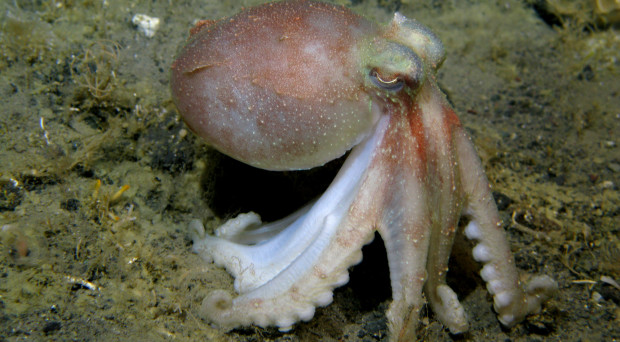
The Antarctic Ocean hosts a rich and diverse fauna despite inhospitable temperatures close to freezing. Living at such cold temperatures poses several physiological challenges to organisms, such as freezing of body fluids, reduced energy production, or slow nerve signaling.
The provision of oxygen however, has not been considered a major challenge. Cold waters are rich in oxygen and reduce the need for oxygen consumption in animals with body temperatures as low as the surrounding waters. This largely reduced the need for active oxygen transport in Antarctic fishes leading to very low concentrations of their blood pigment hemoglobin and in the case of Antarctic icefishes even the complete lack of a blood pigment.
Apart from fishes, octopods are another abundant and diverse group of animals in Southern Ocean waters. They are highly oxygen dependent and have a sophisticated closed oxygen supply system with three hearts, pulsating veins, and high concentrations of a blood pigment, called hemocyanin. This ancient protein is found in many other animals too (e.g. crabs, snails, spiders) and binds oxygen to a central copper ion giving it a blue coloration.
In our study we wanted to find out if Antarctic octopods showed adaptations of their blood pigments similar to Antarctic fishes. Our results showed that contrary to our expectations, Antarctic octopods contain among the highest concentrations of blood pigment reported so far in octopods.
Our results showed that contrary to our expectations, Antarctic octopods contain among the highest concentrations of blood pigment reported so far in octopods.
In the beginning this was very puzzling to us. However, as we looked at the exact way hemocyanin binds oxygen at 0°C we found that only a fraction of the oxygen bound to hemocyanin was released to the tissue.
Although this small fraction already constituted a significant adaptation to the cold, achieved by a reduced affinity for oxygen by hemocyanin, this adaptation seemed incomplete. We concluded that the 40% higher concentration of hemocyanin in the Antarctic octopus Pareledone charcoti compared to octopods from warmer waters, compensated for this incomplete release of oxygen.
This showed that octopods still rely on a blood pigment for oxygen supply at close to freezing temperatures. However, as a trade-off, due to their inability to exploit the full capacity of its hemocyanin at 0°C, they are required to produce more of it.
Another surprising finding was that Pareledone charcoti, is able to release a large fraction of oxygen at 10°C that otherwise remains bound at 0°C. Temperatures of 10°C can be very stressful or even lethal for many Antarctic animals as their demand for oxygen rises. They need to breathe more and require their hearts to pump harder. This additional release of oxygen by hemocyanin at 10°C however, works like a buffer and reduces the stress on other organs like the hearts. This poses a competitive advantage compared to other animals like Antarctic fishes that lack this oxygen buffer or a blood pigment.
Considering the strong warming trend at the Antarctic Peninsula, Pareledone charcoti may eventually benefit from its capacity to adjust blood oxygen supply to more variable temperatures than other species, including Antarctic fish. Although our findings provided significant insights to how Antarctic octopods deal with such cold temperatures we need to understand far more about their physiology and their ecological setting to predict their fate in continuously warming waters.
Comments